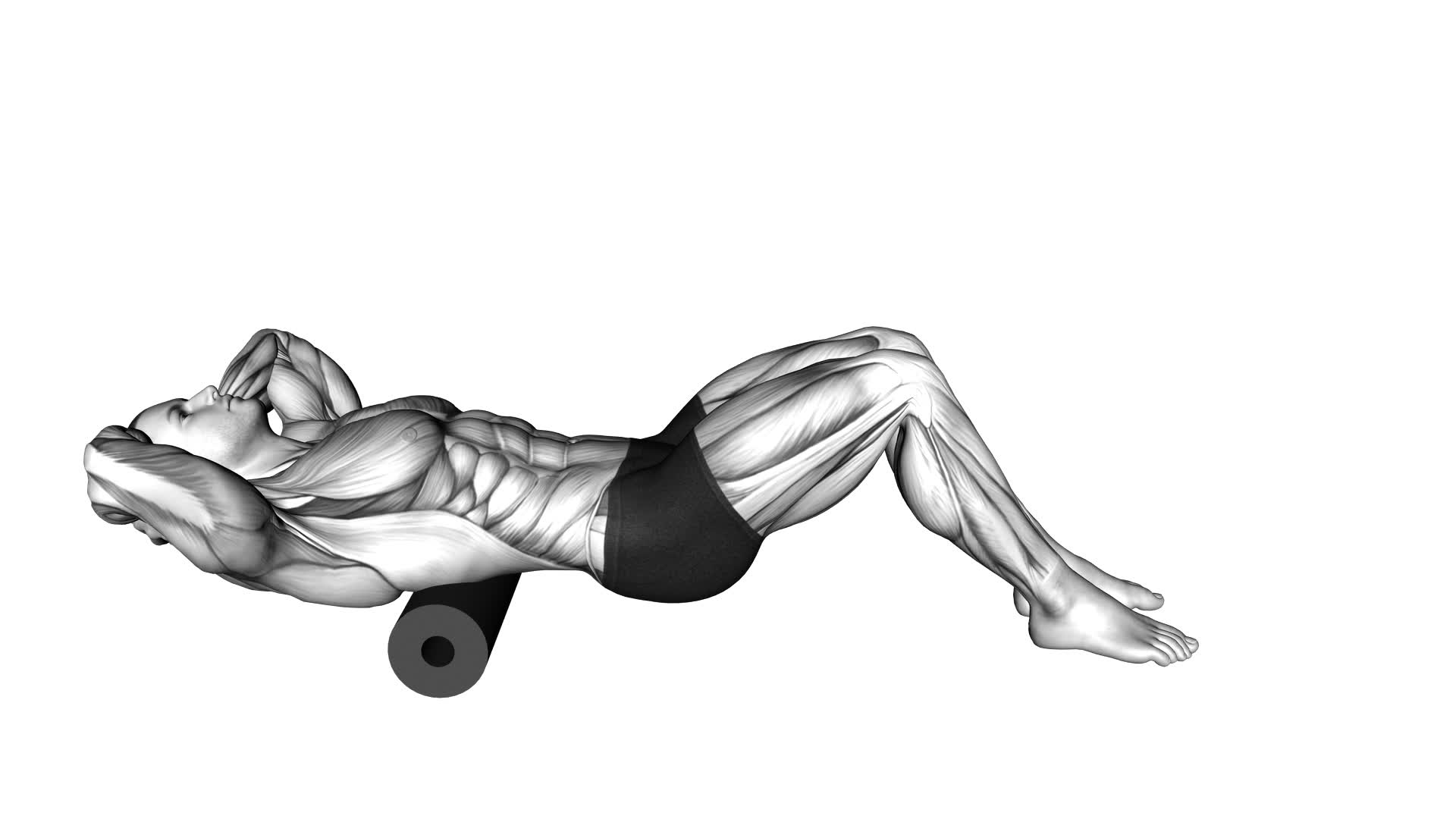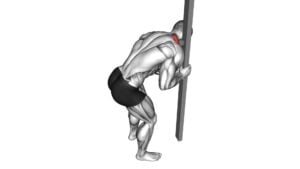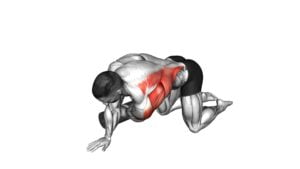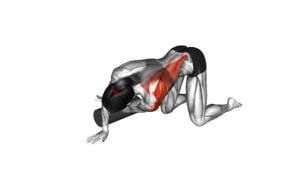Roll Upper Back – Video Exercise Guide & Tips

Are you looking for an effective way to relieve tension and improve mobility in your upper back? Look no further!
Watch This Exercise Video
In this article, we'll guide you through the process of rolling your upper back, complete with a step-by-step video guide and expert tips.
Discover the benefits of this exercise, the equipment you'll need, and common mistakes to avoid.
Get ready to incorporate upper back rolling into your routine for a healthier, more flexible back.
Let's get started!
Key Takeaways
- Rolling your upper back can improve posture and increase flexibility.
- It can alleviate tension and discomfort in the upper back.
- Rolling your upper back enhances overall mobility and reduces the risk of injury.
- It is important to avoid common mistakes such as using improper rolling technique and rolling directly on the spine.
Benefits of Rolling Your Upper Back
Experience relief and improved mobility by incorporating upper back rolling into your fitness routine. Rolling your upper back has several benefits, including improved posture and increased flexibility.
When you spend long hours sitting at a desk or engaging in activities that require hunching over, your upper back muscles become tight and stiff. This can lead to poor posture and limited mobility. By regularly rolling your upper back, you can alleviate tension and discomfort, and improve your overall posture.
Rolling your upper back also helps to increase flexibility. As you roll your spine over the foam roller, it helps to release tight muscles and fascia, allowing for improved range of motion. This increased flexibility not only benefits your upper back but also has a positive impact on your entire body, as it allows you to move more freely and perform exercises with better form.
Incorporating upper back rolling into your fitness routine is a simple and effective way to experience these benefits. By taking just a few minutes each day to roll your upper back, you can improve your posture and increase your flexibility, leading to better overall mobility and reduced risk of injury.
Now that you understand the benefits of upper back rolling, let's move on to the equipment needed for this exercise.
Equipment Needed for Upper Back Rolling
To effectively roll your upper back, you'll need a foam roller and a comfortable space to perform the exercise. There are a few different equipment options available for upper back rolling, but a foam roller is the most common and effective choice. Foam rollers come in various sizes and densities, so you can choose one that suits your preferences and needs.
The best technique for upper back rolling involves lying on the foam roller with it positioned perpendicular to your spine. Place your hands behind your head or cross them over your chest for support. Slowly roll up and down, targeting different areas of your upper back. If you find a particularly tight or tender spot, you can pause and apply gentle pressure to help release tension. Remember to breathe deeply and relax into the movement.
It's important to listen to your body and avoid any positions or movements that cause pain or discomfort.
Regularly incorporating upper back rolling into your exercise routine can help improve posture, reduce muscle tension, and relieve upper back pain.
Step-by-Step Guide to Rolling Your Upper Back
To effectively roll your upper back using a foam roller, follow these step-by-step instructions:
- Position yourself: Start by sitting on the floor with your legs bent and feet flat on the ground. Place the foam roller perpendicular to your upper back, just below your shoulder blades.
- Engage your core: Gently engage your abdominal muscles to stabilize your spine throughout the exercise. This will help maintain proper form and prevent excessive arching or rounding of your back.
- Roll up and down: Using your legs and core, slowly roll back and forth along your upper back. Start at the base of your neck and roll down towards your mid-back, then roll back up towards your shoulders.
- Target specific areas: If you feel any tight or tender spots along your upper back, you can pause and apply gentle pressure on those areas for a few seconds. This will help relieve tension and promote muscle relaxation.
Remember to maintain proper form throughout the exercise. Avoid rolling directly on your spine and keep your movements slow and controlled.
Incorporating this rolling technique into your routine can help improve upper back mobility and alleviate muscle tightness.
Common Mistakes to Avoid When Rolling Your Upper Back
When rolling your upper back, it's important to avoid common mistakes that can hinder the effectiveness of the exercise.
One common mistake is using improper rolling technique. To ensure you're rolling your upper back correctly, start by positioning the foam roller perpendicular to your spine. Then, slowly roll up and down, focusing on the muscles on either side of your spine. Avoid rolling directly on your spine, as this can cause discomfort and potential injury.
Another mistake to avoid is poor posture during the exercise. Make sure to maintain good posture by keeping your core engaged and your shoulders relaxed. This will help you target the right muscles and maximize the benefits of the exercise.
By avoiding these common mistakes, you can ensure that you're performing the upper back rolling technique correctly and effectively.
Now, let's move on to the next section where we'll provide you with some tips for incorporating upper back rolling into your routine.
Tips for Incorporating Upper Back Rolling Into Your Routine
To maximize the benefits of rolling your upper back, incorporate this exercise into your routine by following these tips:
- Proper form for upper back rolling:
- Start by lying on your back with your knees bent and feet flat on the ground.
- Place the foam roller horizontally under your upper back, just below your shoulder blades.
- Cross your arms over your chest or place them behind your head for support.
- Engage your core and lift your hips off the ground, using your feet to roll the foam roller up and down your upper back.
- Take it slow and listen to your body:
- If you're a beginner, start with a softer foam roller or a towel rolled up.
- Begin with gentle movements and gradually increase the pressure as you become more comfortable.
- Pay attention to any areas of tension or discomfort and focus on rolling those areas more.
- Incorporate upper back rolling into your warm-up or cool-down routine:
- Before a workout, rolling your upper back can help loosen tight muscles and improve mobility.
- After a workout, it can aid in muscle recovery and reduce muscle soreness.
- Consistency is key:
- Aim to incorporate upper back rolling into your routine at least 2-3 times a week for optimal results.
- Remember to breathe deeply and relax while rolling to allow your muscles to fully release tension.
Frequently Asked Questions
How Often Should I Roll My Upper Back?
To maximize the benefits of upper back rolling, it's important to consider the frequency of this exercise. Rolling your upper back can help alleviate tension, improve posture, and increase mobility.
However, too much rolling can strain the muscles and potentially cause injury. It's recommended to roll your upper back 2-3 times a week, allowing for proper rest and recovery. This frequency strikes a balance between reaping the benefits and preventing overexertion.
Can Rolling My Upper Back Help With Posture?
Rolling your upper back can definitely help improve your posture. By targeting the muscles in your upper back and neck, rolling can release tension and tightness, allowing for better alignment and positioning of your spine.
This exercise can also help strengthen the muscles that support good posture, promoting a more upright and balanced position. Incorporating rolling into your regular routine can be an effective way to enhance your posture and prevent discomfort or pain associated with poor alignment.
Is It Normal to Feel Some Discomfort or Pain While Rolling My Upper Back?
When rolling your upper back, it isn't uncommon to experience some discomfort or pain. This is because the muscles and tissues in that area may be tight or tense.
However, it's important to manage this discomfort effectively to avoid further injury. If you find the pain to be too intense, you can try alternative techniques such as using a foam roller or seeking assistance from a professional.
Remember to listen to your body and adjust the intensity as needed.
Can Rolling My Upper Back Help With Tension Headaches?
Rolling your upper back can indeed help with tension headaches. By applying pressure and movement to the muscles in your upper back, you can release tension and promote relaxation.
This rolling therapy is an effective way to alleviate the discomfort and pain associated with tension headaches. The benefits of upper back rolling include improved blood flow, increased flexibility, and reduced muscle stiffness.
Incorporating this exercise into your routine can provide relief and prevent future tension headaches.
Are There Any Specific Stretches or Exercises I Should Do Before or After Rolling My Upper Back?
Before or after rolling your upper back, it's important to incorporate a pre-rolling warm-up and a post-rolling cool down.
These stretches and exercises will help prepare your muscles and prevent injury. A pre-rolling warm-up can include gentle neck and shoulder stretches, as well as some light cardio exercises to increase blood flow.
After rolling, a post-rolling cool down should involve stretching the upper back and shoulders to promote relaxation and recovery.
Conclusion
Incorporating upper back rolling into your routine can have numerous benefits, such as improving posture, relieving tension, and increasing flexibility.
By following the step-by-step guide and avoiding common mistakes, you can effectively roll your upper back and experience the benefits.
Remember to use the necessary equipment and make this exercise a regular part of your routine for optimal results.
So start rolling and enjoy a healthier, more mobile upper back!

Author
Years ago, the spark of my life’s passion ignited in my mind the moment I stepped into the local gym for the first time. The inaugural bead of perspiration, the initial endeavor, the very first surge of endorphins, and a sense of pride that washed over me post-workout marked the beginning of my deep-seated interest in strength sports, fitness, and sports nutrition. This very curiosity blossomed rapidly into a profound fascination, propelling me to earn a Master’s degree in Physical Education from the Academy of Physical Education in Krakow, followed by a Sports Manager diploma from the Jagiellonian University. My journey of growth led me to gain more specialized qualifications, such as being a certified personal trainer with a focus on sports dietetics, a lifeguard, and an instructor for wellness and corrective gymnastics. Theoretical knowledge paired seamlessly with practical experience, reinforcing my belief that the transformation of individuals under my guidance was also a reflection of my personal growth. This belief holds true even today. Each day, I strive to push the boundaries and explore new realms. These realms gently elevate me to greater heights. The unique combination of passion for my field and the continuous quest for growth fuels my drive to break new ground.







